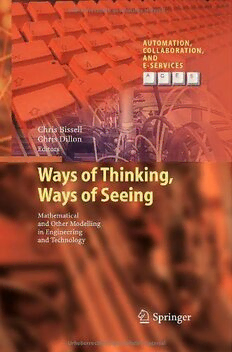Download Ways of Thinking, Ways of Seeing: Mathematical and other Modelling in Engineering and Technology PDF Free - Full Version
Download Ways of Thinking, Ways of Seeing: Mathematical and other Modelling in Engineering and Technology by John Monk (auth.), Chris Bissell, Chris Dillon (eds.) in PDF format completely FREE. No registration required, no payment needed. Get instant access to this valuable resource on PDFdrive.to!
About Ways of Thinking, Ways of Seeing: Mathematical and other Modelling in Engineering and Technology
This fascinating book examines some of the characteristics of technological/engineering models that are likely to be unfamiliar to those who are interested primarily in the history and philosophy of science and mathematics, and which differentiate technological models from scientific and mathematical ones. Themes that are highlighted include: • the role of language: the models developed for engineering design have resulted in new ways of talking about technological systems • communities of practice: related to the previous point, particular engineering communities have particular ways of sharing and developing knowledge • graphical (re)presentation: engineers have developed many ways of reducing quite complex mathematical models to more simple representations • reification: highly abstract mathematical models are turned into ‘objects’ that can be manipulated almost like components of a physical system • machines: not only the currently ubiquitous digital computer, but also older analogue devices – slide rules, physical models, wind tunnels and other small-scale simulators, as well as mechanical, electrical and electronic analogue computers • mathematics and modelling as a bridging tool between disciplines This book studies primarily modelling in technological practice. It is worth noting that models of the type considered in the book are not always highly valued in formal engineering education at university level, which often takes an “applied science” approach close to that of the natural sciences (something that can result in disaffection on the part of students). Yet in an informal context, such as laboratories, industrial placements, and so on, a very different situation obtains. A number of chapters considers such epistemological aspects, as well as the status of different types of models within the engineering education community. The book will be of interest to practising engineers and technologists; sociologists of science and technology; and historians and philosophers of science and mathematics. It will also be written in a way that will be accessible to non-specialists.
Detailed Information
| Author: | John Monk (auth.), Chris Bissell, Chris Dillon (eds.) |
|---|---|
| Publication Year: | 2012 |
| ISBN: | 9783642252082 |
| Pages: | 249 |
| Language: | English |
| File Size: | 3.267 |
| Format: | |
| Price: | FREE |
Safe & Secure Download - No registration required
Why Choose PDFdrive for Your Free Ways of Thinking, Ways of Seeing: Mathematical and other Modelling in Engineering and Technology Download?
- 100% Free: No hidden fees or subscriptions required for one book every day.
- No Registration: Immediate access is available without creating accounts for one book every day.
- Safe and Secure: Clean downloads without malware or viruses
- Multiple Formats: PDF, MOBI, Mpub,... optimized for all devices
- Educational Resource: Supporting knowledge sharing and learning
Frequently Asked Questions
Is it really free to download Ways of Thinking, Ways of Seeing: Mathematical and other Modelling in Engineering and Technology PDF?
Yes, on https://PDFdrive.to you can download Ways of Thinking, Ways of Seeing: Mathematical and other Modelling in Engineering and Technology by John Monk (auth.), Chris Bissell, Chris Dillon (eds.) completely free. We don't require any payment, subscription, or registration to access this PDF file. For 3 books every day.
How can I read Ways of Thinking, Ways of Seeing: Mathematical and other Modelling in Engineering and Technology on my mobile device?
After downloading Ways of Thinking, Ways of Seeing: Mathematical and other Modelling in Engineering and Technology PDF, you can open it with any PDF reader app on your phone or tablet. We recommend using Adobe Acrobat Reader, Apple Books, or Google Play Books for the best reading experience.
Is this the full version of Ways of Thinking, Ways of Seeing: Mathematical and other Modelling in Engineering and Technology?
Yes, this is the complete PDF version of Ways of Thinking, Ways of Seeing: Mathematical and other Modelling in Engineering and Technology by John Monk (auth.), Chris Bissell, Chris Dillon (eds.). You will be able to read the entire content as in the printed version without missing any pages.
Is it legal to download Ways of Thinking, Ways of Seeing: Mathematical and other Modelling in Engineering and Technology PDF for free?
https://PDFdrive.to provides links to free educational resources available online. We do not store any files on our servers. Please be aware of copyright laws in your country before downloading.
The materials shared are intended for research, educational, and personal use in accordance with fair use principles.

